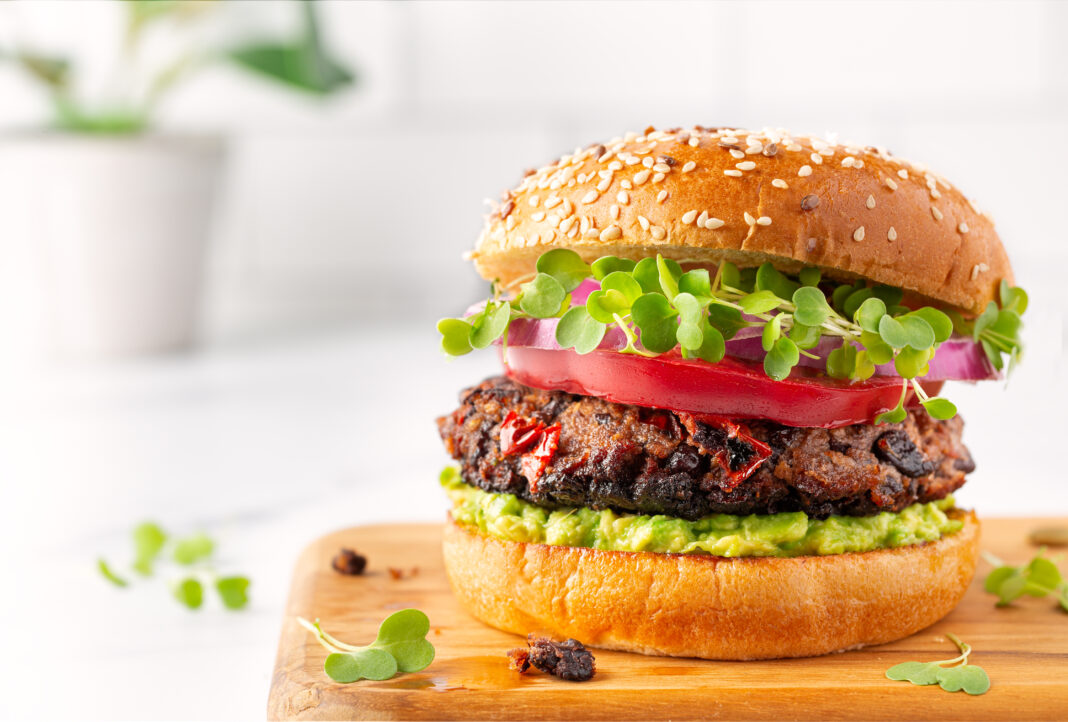Plant-based patties that closely replicate beef are everywhere, from the supermarket meat aisles to fast-food drive-throughs and gourmet restaurants. These meaty products are nothing like the old school veggie burgers we know and love, and many people are unsure what to make of them.
Should you embrace meaty veggie burgers?
It makes sense that there’s a lot of confusion and controversy around whether or not these burgers can be part of a healthy diet.
On the one hand, they come from plants, taste decadent, and avoid the many downsides of meat. Compared to beef, they are better for your health, cruelty-free, and friendlier to the planet.
On the other hand, they bear little to no resemblance to the veggies that went into them. Due to their processed nature and long ingredient list, plant-based burgers have been challenged not only by the meat industry, but also by whole foods devotees, and labelled as “processed junk food.”
For many, it’s clear that plant-based burgers are a better choice than beef. For vegans, it’s not as simple. It depends a lot on what you’d be eating otherwise, how you consume them, and how they fit into your bigger picture. Let’s take a closer look at what these burgers do—and do not—deliver.
The main nutritional downside of faux meat patties is what they lack—they have lost much of the fibre, vitamins, minerals, and phytonutrients that whole plants provide, due to processing.
A plant-based meat mimic usually only has a few grams of fibre, roughly half of what you’d get in a store-bought traditional veggie patty (such as Dr. Praegar), and far less than a bowl of whole legumes.
These patties definitely don’t count towards your daily veggies!
On the plus side, plant-based burgers deliver an impressive whack of high-quality plant-based protein. Most plant-based meat mimics contain around 20 grams of protein per patty (typically from soy or pea protein isolates), which is on par with a typical ground beef patty (80 per cent beef, 20 per cent fat).
For anyone looking to dial up their protein to support muscle growth, this is an easy way to get a boost.
Many meat analogues also provide valuable vitamins and minerals that vegans often need to boost, including iron and vitamin B12. (See nutritional chart). Other aspects of the nutritional profile, like fat, sodium, and calorie content, can’t simply be defined as “good” or “bad” because the right answer for you depends on a few factors.
Meat-like plant-based patties typically contain a generous serving of fats, to the tune of 14 to 18 grams per patty. Most of this fat is from unsaturated vegetable oils (like canola oil), but a decent portion (5 to 8 grams) is from saturated fats (e.g. coconut oil), that give a richer texture and mouthfeel. The fats in these patties can be part of a healthy, well-balanced diet, but don’t fit well into an ultra-low-fat diet.
The sodium content of processed plant-based burgers is worth paying attention to. On the high end, some patties contain nearly 400 mg of sodium, about one sixth of the 2,300 mg that most of us should aim to stay well under.
This amount of sodium is not a deal-breaker for most of us, but could be challenging for those
following low-sodium diets. Sodium levels can also be concerning if we regularly frequent fast-food joints where plant-based burgers commonly deliver over 1,000 mg thanks to heaps of sodium in the bun and sauces (not to mention the fries!).
Notably, store-bought bean patties and many other processed veggie products are not far behind when it comes to sodium.
The overall calorie content of processed plant-based burgers is high compared to most legume-based patties, at roughly 240 to 250 kcal per patty. Calories are not inherently bad, but, for optimal health we want most of our calories to be nutrient rich.
The impact of a plant-based patty on overall energy intake and nutrient density depends a lot on how it’s served. A patty served at home on a whole wheat bun with a generous salad can still be a nutrient-dense meal.
On the other hand, a 1,000-calorie fast-food burger on a white bun with lots of sauce and a side of fries, is not.
Whether or not the calorie count matters also depends on your energy needs and goals: are you a young, active person with high energy demands, or an older person who is trying to lose weight?
One final aspect worth understanding is ingredients that may be unfamiliar. These ingredients have all been tested and approved by regulators as safe (in moderation) and become a lot less scary once you understand them.
For example, leghemoglobin is used to make burgers ‘bleed’ and cook like beef. It may sound scary, but it’s nothing more than a plant-based version of the hemoglobin that flows through our bodies and helps carry iron.
In nature, leghemoglobin is found in the root nodules of certain legumes (like soy). For efficiency, leghemoglobin is often made using microbial fermentation.
While we may yearn to label foods as “good” or “bad,” reality is often more nuanced. When choosing what to eat, we need to consider the health and nutritional profile of the whole meal, what we would be eating otherwise, and our overall dietary goals.
Personal preference is another important factor. You may find the thought of meat disgusting, while someone else may miss the taste of meat (like my husband) and find that meat analogues help them happily abstain from the real thing.
Finally, there’s something to be said for moderation, and for not letting perfect be the enemy of good. Remember, not all plant-based burgers on the market are created alike, and preparing your own versions with whole foods will always yield the healthiest results.
You May Also Like: Eating Plants for Better Gut Health

Read This Story in our 2023 Fall Fitness & Food Issue
Featuring this year’s winners of the Amazing Race Canada, Ty Smith and Kat Kastner on our cover. Inside our latest issue, you’ll find all the inspiration you need to carry you through the autumn season. From delicious high-protein recipes and how to resist the crunch of potato chips to running through the high peaks of the Colorado Rockies and the latest in nutrition and fitness, these pages are packed with expert knowledge and advice.

















